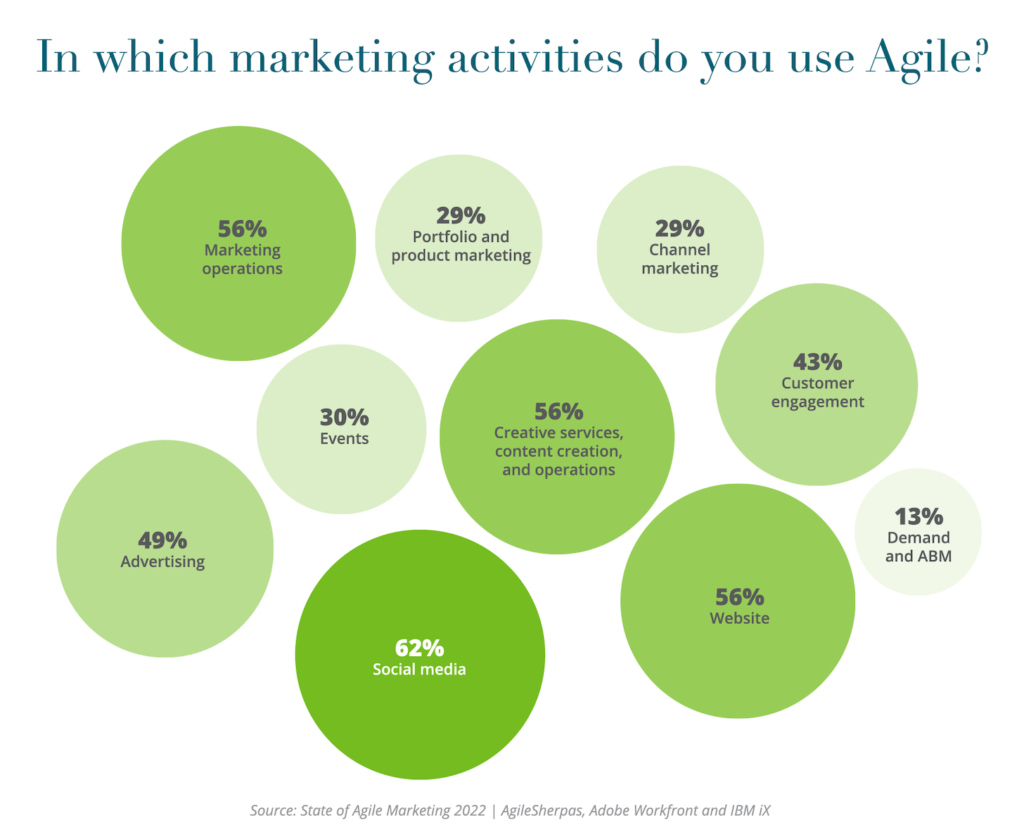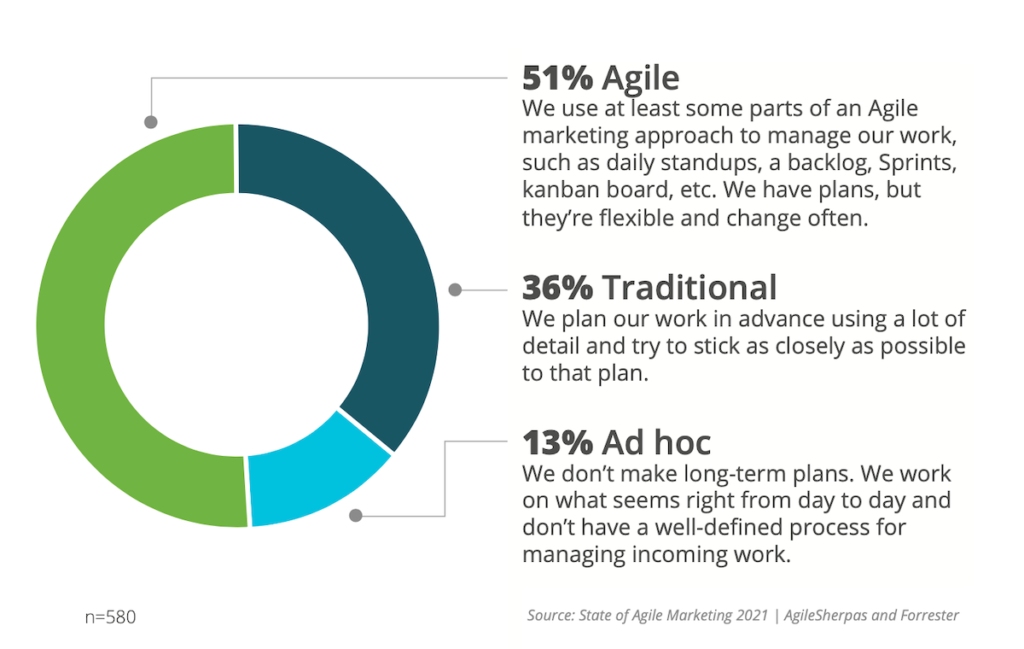Today I’m presenting a new talk on agile marketing that walks through a Scrum-inspired agile methodology and tackles several of the common myths and misconceptions people have about agile management.
If you’ve been hearing about agile marketing but are a little fuzzy about the actual process — or if you have concerns that agile is just a euphemism for “work faster” or “do it quick and dirty” or “a lack of a guiding plan” — then I hope you’ll find this presentation helpful.
Here’s the slide deck, which I’ve annotated heavily to make it a self-guided tour:
Are you using some incarnation of agile marketing in your organization? If so, I’d love to hear your perspective and experience.
Have other questions or concerns that these slide didn’t answer? Ask away!



Scott,
This is a fantastic articulation of some pretty complex stuff. I watched your presentation on Youtube a week or so ago, and thought it wonderful, and had a look through the slides, but the annotations have made it Live.
Thanks
Allen Roberts.
Thanks, Allen — I’m really glad you liked this and found it helpful.
This is a great overview of the Agile management systems, but you don’t really provide an explanation of how it could or would be applied to the operations of a marketing unit of a business.
I’ve managed large and small digital marketing teams for agencies or companies for almost 20 years now. I’ve applied agile methodologies to software development with success and with failures. One thing that is important to the agile process is that the team is very focused on a collaborative goal at hand. I’ve found that marketing units are often not organized in a manner that would make an agile approach productive.
Would welcome your thoughts..
Thanks, Bryan.
This presentation is definitely far from a comprehensive treatise on adapting agile to marketing. Since I’ve seen a lot of marketing departments experimenting with variations on agile, I thought it would be helpful in a 30-minute-sized presentation to provide some foundation.
But the bigger issue you raise — that most marketing departments are not currently organized in a way to take advantage of this kind of methodology — is a fair concern. Of course, I’d say that most marketing departments are also struggling with the challenges I outlined in the first part of this presentation. Since these challenges seem only to be intensifying, I believe we will see more marketing departments motivated to try new configurations.
I agree that a collaborative goal is important. But I’ve also seen agile teams where that collaborative goal is big and/or evolves over time. It becomes an ongoing way of working together, not just a finite project.
I’m curious where I can find the YouTube video that STRATEGYAUDIT described in his post — I was unsuccessful in searching for it at YouTube. I teach college courses in marketing online/hybrid/in-the-classroom for a large, public university, and I find your videos, blogs, etc. helpful for students to appreciate lifelong learning as future marketers.
Deborah,
I will save Scott the trouble.
The link is below, enjoy and learn.
http://watch.knowledgevision.com/f3f9a64c4ac64ddf8982b85dddc579b5
Allen Roberts
Thanks so much, Allen — I do appreciate it. FYI: My students (undergraduate marketing majors) have been intimidated by 1.0 and 2.0 — I can just imagine their reaction to 3.0
Deb
Deb, Glad to help.
Marketing when I did it (graduated 1972, so I was an early adopter) was pretty substantial stuff, a lot of stats and quantitative research techniques, as well as the basics of branding and behavior. Over the years, running large marketing departments,and business units, i found the standard of the kids coming through was becoming progressively lower, as marketing became the uni course to do if you could not get into anything difficult. I found this frustrating and demeaning, and found I had to hire those with a professional qualification, science, accounting, et al, to get the standard of thinking I needed.
Now, full circle. The numeracy and intellectual agility required to be a good marketer has increased enormously with the advent of all this new stuff in the last few years. Scott particularly is doing a great job highlighting the combination of quantitative analysis with insight and instinct developed by market intimacy, and it is no longer an easy road.
Cheers
Allen
Hi Scott,
Long time fan of Chiefmartec blog and thanks for sharing your preso and for promoting the agile marketing mindset.
I am a strong believer in the agile approach/mindset for marketing and have been part of agile initiates at multiple companies, and have seen it from different angles. In one marketing company they introduced Agile to the entire marketing organization (~300 people), and introduced 10+ SCRUM teams focused on different initiatives from website conversion optimization, to event planning where different marketing functions were trained on SCRUM and part of daily standups, sprint plannings, demos, retrospectives, etc. There was even a SCRUM of SCRUMS to manage collisions across SCRUMs. At another company they introduced 3-4 SCRUM teams to operationalize a optimization/testing program running 100+ tests per month and other marketing and ecommerce initiatives, in that approach the SCRUM team was mostly marketing operation teams (dev, QA, copy, design, merchandising) and marketing teams served as product owners.
In both cases it dramatically improved collaboration across the organization, and often accelerated velocity. At the same time there were challenges sustaining momentum, engagement, and excitement around it over time, especially when moving from an executive initiative to run state inside the company. In the first example where the marketing groups were in SCRUM some of the challenges were in deciding how much time was spent in SCRUMs vs. outside, as some people’s roles did not align well to the stories in each SCRUM. So some folks were utilized and others were not from scrum to scrum, and marketing tasks were not as transferable within the team as it may be with development scrums where a designer or developer or QA resource can more easily backup each other (as we had multiple of each in a SCRUM).
And in both cases success and failure was really dependent on the quality of their scrum master and/or product owner. In general, it requires a top talent to apply agile to the business world, especially early on within the organization and especially because marketer folks don’t love structure 🙂
I also found personal success when I ran my own cross-functional team for optimization. While we didn’t adopt a traditional SCRUM approach internally we interfaced with SCRUM teams. I managed a team that contained business facing, development, and analytics leads within a single 10 person team. It worked really well as we had everything needed within one team and we had great velocity and we able to deliver some pretty advanced projects because the team had a single leader and single set of priorities and worked well together.
We also tried introducing SCRUM to a marketing analytics department, but we always struggled there because some projects fit well and other didn’t, and we had more specialists and were less cross-trained so it was harder to make it work. And in general, the management and stakeholder level just wasn’t the right fit for a SCRUM approach.
In the end, i think going Agile for a marketing organization is something i would highly recommend, but be prepared for a lot of challenges. In general, organizations have to invest heavily to make any introduction of Agile work (even in dev/IT), its even more challenging when its introduced to the business/marketing side of the house. I think the key is apply one of your slides where you don’t try to be a agile purist, you need to apply the agile mindset but be very comfortable tweaking and customizing agile for your organization, your team, and even by project and function.
I hope/expect as marketing organizations continue to adopt the agile approach that we will see significant improvements in our ability to plan, organize, and work together applying this much more effective self organizing approach to delivering marketing.
Keep up the great job of helping change digital marketing for the better.
James Niehaus
Thanks for this presentations Scott! It’s the best I’ve read as I’ve been researching agile marketing. I’m now leading a team that is doing a scrum and sprint process and now have some new ideas about how to improve that process.